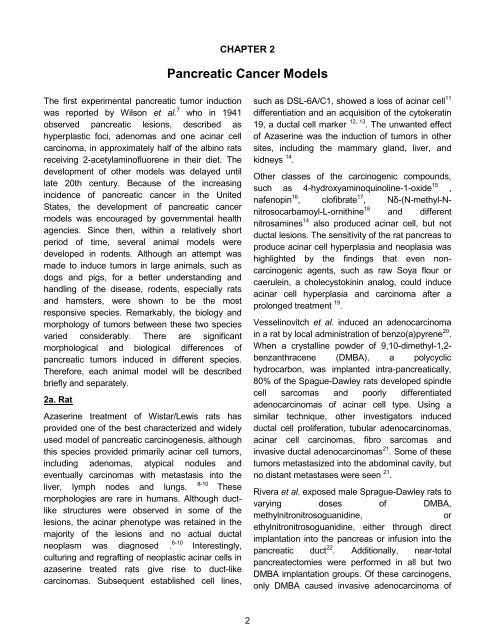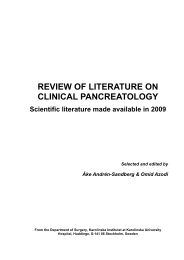Download PDF - The Pancreapedia
Download PDF - The Pancreapedia
Download PDF - The Pancreapedia
Create successful ePaper yourself
Turn your PDF publications into a flip-book with our unique Google optimized e-Paper software.
<strong>The</strong> first experimental pancreatic tumor induction<br />
was reported by Wilson et al. 7 who in 1941<br />
observed pancreatic lesions, described as<br />
hyperplastic foci, adenomas and one acinar cell<br />
carcinoma, in approximately half of the albino rats<br />
receiving 2-acetylaminofluorene in their diet. <strong>The</strong><br />
development of other models was delayed until<br />
late 20th century. Because of the increasing<br />
incidence of pancreatic cancer in the United<br />
States, the development of pancreatic cancer<br />
models was encouraged by governmental health<br />
agencies. Since then, within a relatively short<br />
period of time, several animal models were<br />
developed in rodents. Although an attempt was<br />
made to induce tumors in large animals, such as<br />
dogs and pigs, for a better understanding and<br />
handling of the disease, rodents, especially rats<br />
and hamsters, were shown to be the most<br />
responsive species. Remarkably, the biology and<br />
morphology of tumors between these two species<br />
varied considerably. <strong>The</strong>re are significant<br />
morphological and biological differences of<br />
pancreatic tumors induced in different species.<br />
<strong>The</strong>refore, each animal model will be described<br />
briefly and separately.<br />
2a. Rat<br />
Azaserine treatment of Wistar/Lewis rats has<br />
provided one of the best characterized and widely<br />
used model of pancreatic carcinogenesis, although<br />
this species provided primarily acinar cell tumors,<br />
including adenomas, atypical nodules and<br />
eventually carcinomas with metastasis into the<br />
8-10<br />
liver, lymph nodes and lungs. <strong>The</strong>se<br />
morphologies are rare in humans. Although ductlike<br />
structures were observed in some of the<br />
lesions, the acinar phenotype was retained in the<br />
majority of the lesions and no actual ductal<br />
neoplasm was diagnosed . 8-10<br />
Interestingly,<br />
culturing and regrafting of neoplastic acinar cells in<br />
azaserine treated rats give rise to duct-like<br />
carcinomas. Subsequent established cell lines,<br />
CHAPTER 2<br />
Pancreatic Cancer Models<br />
2<br />
such as DSL-6A/C1, showed a loss of acinar cell 11<br />
differentiation and an acquisition of the cytokeratin<br />
19, a ductal cell marker 12, 13 . <strong>The</strong> unwanted effect<br />
of Azaserine was the induction of tumors in other<br />
sites, including the mammary gland, liver, and<br />
kidneys 14 .<br />
Other classes of the carcinogenic compounds,<br />
such as 4-hydroxyaminoquinoline-1-oxide 15 ,<br />
nafenopin 16 , clofibrate 17 , Nδ-(N-methyl-Nnitrosocarbamoyl-L-ornithine<br />
18 and different<br />
nitrosamines 14 also produced acinar cell, but not<br />
ductal lesions. <strong>The</strong> sensitivity of the rat pancreas to<br />
produce acinar cell hyperplasia and neoplasia was<br />
highlighted by the findings that even noncarcinogenic<br />
agents, such as raw Soya flour or<br />
caerulein, a cholecystokinin analog, could induce<br />
acinar cell hyperplasia and carcinoma after a<br />
prolonged treatment 19 .<br />
Vesselinovitch et al. induced an adenocarcinoma<br />
in a rat by local administration of benzo(a)pyrene 20 .<br />
When a crystalline powder of 9,10-dimethyl-1,2benzanthracene<br />
(DMBA), a polycyclic<br />
hydrocarbon, was implanted intra-pancreatically,<br />
80% of the Spague-Dawley rats developed spindle<br />
cell sarcomas and poorly differentiated<br />
adenocarcinomas of acinar cell type. Using a<br />
similar technique, other investigators induced<br />
ductal cell proliferation, tubular adenocarcinomas,<br />
acinar cell carcinomas, fibro sarcomas and<br />
invasive ductal adenocarcinomas 21 . Some of these<br />
tumors metastasized into the abdominal cavity, but<br />
no distant metastases were seen 21 .<br />
Rivera et al. exposed male Sprague-Dawley rats to<br />
varying doses of DMBA,<br />
methylnitronitrosoguanidine, or<br />
ethylnitronitrosoguanidine, either through direct<br />
implantation into the pancreas or infusion into the<br />
pancreatic duct 22 . Additionally, near-total<br />
pancreatectomies were performed in all but two<br />
DMBA implantation groups. Of these carcinogens,<br />
only DMBA caused invasive adenocarcinoma of












